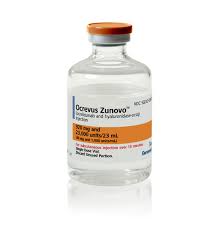A 10-minute injection or a two-hour infusion? Which would you prefer to treat your multiple sclerosis (MS)?
That choice is now available, following the U.S. Food and Drug Administration’s approval of Ocrevus Zunovo in mid-September.
The treatment combines Genentech’s very popular Ocrevus with ocrelizumab with a drug delivery system called Enhanze. Ocrevus, according to Genentech, has been used to treat more than 350,000 people with MS (PwMS) since it was approved in 2017. But the treatment requires at least two hours of infusion time, every six months, plus additional time to watch for possible side effects. Ocrevus Zunovo, on the other hand, only requires 10-minutes for an injection under the skin, plus about 30 minutes of pre-medications and 15 minutes of post-injection monitoring (60 minutes following the first treatment) twice a year.
According to the OCARINA 2 clinical trial, Ocrevus by an injection is as effective as the infusion. The injection does require a larger dose of the medication than does the infusion, 920 mg versus 600 mg, but Genentech’s medical director for MS, David Jones, told Fierce Pharma that’s to be expected, because not all of the drug is going to be absorbed, as would be the case with an infusion.
That trial also concluded the safety profile of Ocrevus Zunovo was consistent with the safety profile of the infusion. The most common adverse events were mild or moderate injection reactions. More than 92% of trial participants reported being satisfied or very satisfied with the injection.
Will patients and doctors buy-in to Ocrevus Zunovo?
I participated in the Phase 3 trial of Avonex (interferon beta-1a) back in the mid-1990s and I continued treatment with that medication for about seven years. Eventually I got “needle fatigue” and switched to Tysabri (natalizumab), a monthly infusion. I found that spending a little over an hour in a comfortable recliner once a month was far easier for me than injecting myself in my thigh muscle once a week. Ocrevus Zunovo, however, is injected by a healthcare provider and it’s injected under the skin, not into the muscle. I think that process should be a lot easier on a patient than what I did with Avonex.
What about pills? I’ve also been treated with Aubagio (teriflunomide), a daily oral medication. Pills are certainly easy to take and they’ve gained a lot of traction in the MS world over the years. A study published in JAMA Neurology in July 2023 reported that between 2000 and 2020 prescribing an injectable medication as an adult’s first MS treatment declined a whopping 73.8%. On the other hand, by the end of 2020 there were eight pills on the market — and they garnered 62.3% of the initial DMT orders.
That Rutgers University research suggested several reasons for this growing preference for pills. They include efficacy, tolerability, safety, and cost — and, as I wrote several years ago, cost is often a big elephant in the treatment room when treatments are being discussed.
There are a lot of pluses
So, if pills are so popular does marketing another MS injection make sense? I think it does. Unlike the injections of the 1990s, Ocrevus Zunovo is reported to be highly effective at treating MS. Also, it’s not self-injected, and it’s approved for all relapsing forms of MS (CIS, Relapsing and Active Secondary Progressive). Its semi-annual schedule of relatively short treatment visits should fit most lifestyles, and its side-effects seem minimal.
The medication appears to have a lot going for it. But, there’s still that elephant in the room. Will insurance in the U.S. cover Ocrevus Zunovo without a fight and will government health plans in other countries approve it?
We should soon have a better idea of that as Ocrevus Zunovo starts to become available to MS patients in the U.S. Stay tuned.
(This post was first published on the Rare Disease Advisor website.)



